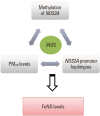Environmental changes, microbiota, and allergic diseases
- PMID: 25228995
- PMCID: PMC4161679
- DOI: 10.4168/aair.2014.6.5.389
Environmental changes, microbiota, and allergic diseases
Abstract
During the last few decades, the prevalence of allergic disease has increased dramatically. The development of allergic diseases has been attributed to complex interactions between environmental factors and genetic factors. Of the many possible environmental factors, most research has focused on the most commonly encountered environmental factors, such as air pollution and environmental microbiota in combination with climate change. There is increasing evidence that such environmental factors play a critical role in the regulation of the immune response that is associated with allergic diseases, especially in genetically susceptible individuals. This review deals with not only these environmental factors and genetic factors but also their interactions in the development of allergic diseases. It will also emphasize the need for early interventions that can prevent the development of allergic diseases in susceptible populations and how these interventions can be identified.
Keywords: Allergic disease; climate change; epigenetics; gene-environmental interaction; microbiota; pollution.
Conflict of interest statement
There are no financial or other issues that might lead to conflict of interest.
Figures




References
-
- Renz H, von Mutius E, Brandtzaeg P, Cookson WO, Autenrieth IB, Haller D. Gene-environment interactions in chronic inflammatory disease. Nat Immunol. 2011;12:273–277. - PubMed
-
- Greer RL, Morgun A, Shulzhenko N. Bridging immunity and lipid metabolism by gut microbiota. J Allergy Clin Immunol. 2013;132:253–262. - PubMed
-
- Prescott SL, Clifton V. Asthma and pregnancy: emerging evidence of epigenetic interactions in utero. Curr Opin Allergy Clin Immunol. 2009;9:417–426. - PubMed
Publication types
LinkOut - more resources
Full Text Sources
Other Literature Sources

